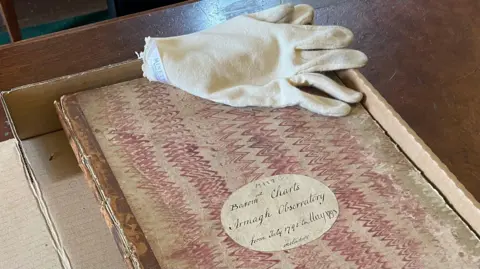**Celebrating 230 Years of Weather Observation: Armagh Observatory’s Milestone**
Armagh Observatory is proudly commemorating a remarkable milestone—230 years of unbroken weather observation. Since its inception in 1795, the observatory has established itself as a hub of meteorological studies, boasting the longest continuous weather record in both the UK and Ireland. This significant occasion has prompted a series of events at the observatory, showcasing its rich history and enduring contributions to the field of meteorology.
The tradition of handwritten data collection at Armagh Observatory is uniquely special. Nowadays, most weather data is collected through automated systems, but Armagh still relies on human involvement to maintain its records. This personal touch not only honors the facility’s legacy but also underscores the value of direct human observation in understanding weather patterns and phenomena.
The very first measurements at the observatory were taken on July 14, 1795. Armed with a graph to record temperature and air pressure, the efforts of the early meteorologists set a precedent for future generations. This daily recording ritual has continued unfalteringly ever since, spanning an impressive 230 years. Shane Kelly, the current principal meteorological observer, has become an integral part of this tradition. Since 1999, Kelly has meticulously taken daily readings, meticulously recording his observations in a ledger, continuing the legacy established by the observatory’s founders. Notably, his contributions exceed those of his 17 predecessors, emphasizing the dedication and consistency inherent in the observatory’s practices.
Kelly reflects on his connection to the observatory, stating that he feels almost like a part of the infrastructure itself—an embodiment of its storied history. His experience over the past 25 years has provided him with a front-row seat to the evolving patterns of weather. With seasons becoming less distinct and increasingly blurred into one another, Kelly anticipates further challenges posed by climate change.
Armagh’s historical span of weather data begins at a time when meteorology was still in its infancy, pre-dating the influential work of Luke Howard, whose seminal 1803 book on cloud classification paved the way for modern meteorological studies. The records from Armagh are not only foundational but also rich with significant observations, documenting extraordinary events such as auroras and early sightings of noctilucent clouds. One notable entry from January 6, 1839, describes a “tremendous gale,” an understated account of a storm that tragically cost the lives of 250 to 300 individuals.
The observatory has also seen contributions from exceptional figures throughout its history, including guest meteorologist Romney Robinson. In 1908, Robinson’s innovations in measuring wind speed led to the creation of the four-cup anemometer, a device that quickly became vital in meteorological studies worldwide. Dr. Rok Nežič, the observatory’s tours and outreach officer, highlights this invention and its lasting influence on weather measurement, underscoring its practical application even in the present day.
Among the many contributors to the observatory’s storied legacy, Theresa Hardcastle stands out as a remarkable figure. In the wake of her husband’s death during his tenure as the director of the observatory, Cashfield transitioned into his role, continuing vital weather recordings. The sheer courage and resilience she demonstrated have led to her being recognized as an “unsung hero” within the narrative of Armagh Observatory, emphasizing the importance of her contributions.
Presently, Armagh Observatory continues to dawn a brighter future through its commitment to training aspiring meteorologists and astronomers from around the globe. Professor Michael Burton, the current director, emphasizes the importance of hands-on data collection, asserting that understanding the science of weather measurement entails an active engagement with the elements. The observatory’s focus remains firmly planted on nurturing the scientists of tomorrow while maintaining its cherished historical practices.
As Armagh Observatory looks forward to many more years of service, it remains a touchstone for meteorological research, bridging the gap between humanity and the ever-evolving rhythms of weather and climate.











